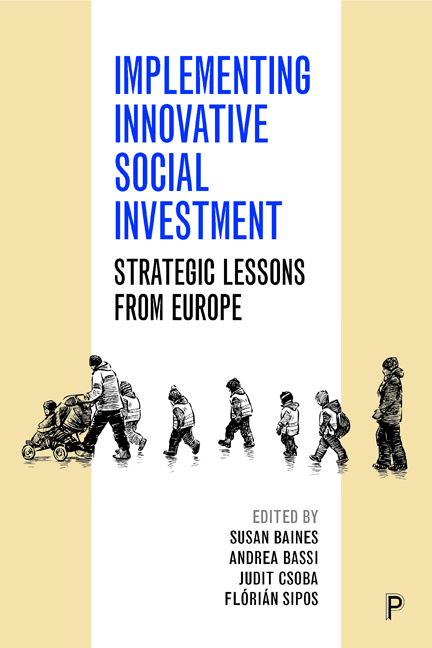Book contents
- Frontmatter
- Contents
- List of tables, figures, images and boxes
- Notes on contributors
- Acknowledgement
- one Social Investment in welfare: a sub-national perspective
- Part A Children and families: early intervention in people’s life courses
- Part B From a caring state to an investing state: labour market activation
- Part C Social solidarity and Social Investment
- Index
one - Social Investment in welfare: a sub-national perspective
Published online by Cambridge University Press: 21 April 2022
- Frontmatter
- Contents
- List of tables, figures, images and boxes
- Notes on contributors
- Acknowledgement
- one Social Investment in welfare: a sub-national perspective
- Part A Children and families: early intervention in people’s life courses
- Part B From a caring state to an investing state: labour market activation
- Part C Social solidarity and Social Investment
- Index
Summary
Introduction
The concept of a Social Investment welfare paradigm has become highly influential in public policy globally (Deeming and Smyth, 2017). At its heart lies the idea that welfare states must invest to strengthen skills and capacities, beginning in early life. ‘Social Investment’ therefore refers to policies and interventions that aim to build the productive capacities of citizens (Deeming and Smyth, 2015). Typical examples include labour market activation and early years education and care (Hemerijck, 2017). According to the European Commission (2013: 3): ‘[S]ocial investment policies reinforce social policies that protect and stabilise by addressing some of the causes of disadvantage and giving people tools with which to improve their social situations’. Many countries – including but not limited to members states of the European Union (EU) – have adopted some elements of Social Investment, although uptake is far from uniform (Bouget et al, 2015).
Social Investment calls into question past welfare policy paradigms (Van Kersbergen and Hemerijck, 2012). Indeed, according to its advocates, it amounts to ‘a paradigmatic rethink of active welfare states for the 21st century knowledge economy’ (Hemerijck, 2017: 66). The scholarly literature on Social Investment focuses heavily on aggregate effects and the macro-comparative analysis of welfare spending (Kuitto, 2016). As a result, debates often remain on an abstract meta-level and make limited reference to local and micro-level implementation and practice. In contrast to most writing on Social Investment, this book brings sub-national contexts to the fore. It does this with original, empirical research evidence about successes, challenges and setbacks from 10 countries.
It is the idea of having a lasting impact that gives Social Investment policies the characteristics of an ‘investment’ by offering some returns over time. This meaning of the term ‘social investment’ is somewhat distinct from its more typical usage in the UK and other Englishspeaking countries to denote financial mechanisms such as Payment by Results (PbR) and Social Impact Bonds (SIBs) for funding social programmes. Financial mechanisms are not the main focus of this book, although we do consider some aspects of financial innovation.
Innovation is an essential element of Social Investment as social policies require constant adaptation to new challenges (Jenson, 2015). Social innovation is concerned with ‘the development of what are currently viewed as assets for sustainable development: environmental, human and social capital’ (BEPA, 2010).
- Type
- Chapter
- Information
- Implementing Innovative Social InvestmentStrategic Lessons from Europe, pp. 1 - 22Publisher: Bristol University PressPrint publication year: 2019
- 1
- Cited by



